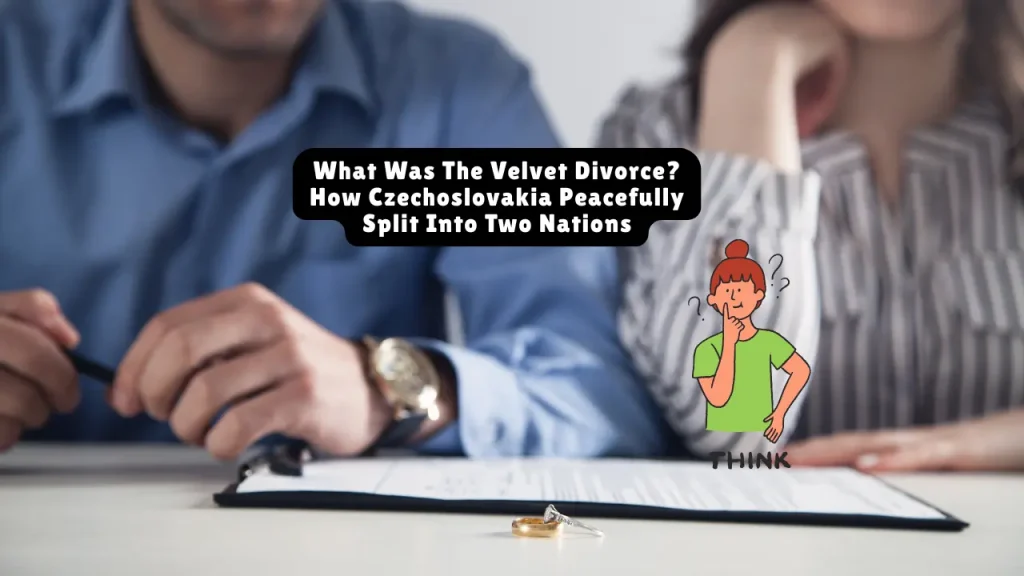What Was The Velvet Divorce? How Czechoslovakia Peacefully Split Into Two Nations
When nations break apart, the story is usually one of violence, protests, and bitter disputes. But in 1993, Czechoslovakia did something remarkable: it dissolved into two sovereign states — the Czech Republic and Slovakia — without bloodshed, forced displacement, or civil war. This rare and peaceful separation became known as the Velvet Divorce, a term evoking softness, civility, and dignity.
Here’s how this historic event unfolded, why it happened, and what lessons it offers for modern conflicts — even at the family or national level.
Table of Contents
A Brief Background, One Nation, Two Identities
Czechoslovakia was created in 1918, uniting the Czech lands (Bohemia and Moravia) with Slovakia after the fall of the Austro-Hungarian Empire.
For decades, the two peoples cooperated under communist rule, bound by shared Slavic roots and a common government. Yet, cultural, political, and economic differences simmered beneath the surface.
After the Velvet Revolution of 1989, which peacefully ended communism in Czechoslovakia, these differences became more pronounced.
Why Did the Velvet Divorce Happen?
The split wasn’t inevitable — but it was the result of three major forces.
1. Political and Economic Disagreements
- Czech leaders pushed for rapid privatization, free-market reforms, and integration with the West.
- Slovak leaders wanted a slower transition, with more state protections for workers and industries.
- Many Czechs felt they were subsidizing Slovakia, while Slovaks resented Prague-centric policies.
2. The “Hyphen War”
In 1990, a debate erupted over renaming the country to “Czecho-Slovakia,” signaling Slovak demands for equal recognition. This symbolic dispute highlighted deeper identity issues.
3. Rising Nationalism
Post-communist freedoms allowed nationalist politicians — like Václav Klaus (Czech) and Vladimír Mečiar (Slovak) — to champion independence as a path to prosperity and self-respect.
Related article: Divorce Before Green Card Interview, Critical Legal Guide for Immigrant Couples
How the Split Happened: Democracy in Action
Unlike other dissolutions of the era, the Velvet Divorce was decided by elected representatives, not the streets or battlefields.
- June 1992 elections:
Klaus’s Civic Democratic Party won in the Czech lands, while Mečiar’s Movement for a Democratic Slovakia triumphed in Slovakia. Both favored separation. - November 1992:
The federal parliament passed Constitutional Law 542, formally dissolving the country, with overwhelming support from both Czech and Slovak MPs. - January 1, 1993:
At midnight, Czechoslovakia ceased to exist. The Czech Republic and Slovakia were born — recognized internationally overnight.
There was no referendum, and surveys suggested only about 37% of Slovaks and 36% of Czechs supported separation at the time. But most accepted the outcome gracefully.
Related article: Worst Age for Divorce for Children

Dividing the Assets: A Civilized Settlement
Like amicable roommates splitting their belongings, the two nations carefully negotiated how to divide property and responsibilities:
| Asset | Agreement |
| National wealth | Split 2:1 based on population |
| Federal property | Distributed locally (embassies, tanks, etc.) |
| Currency | Shared temporarily, then each introduced its own |
| Citizenship | Residents became citizens of their respective republics |
| Sports & culture | Some teams, like the ice hockey team, competed jointly one last time |
Aftermath, Challenges and Triumphs
Economic Paths
Initially, the Czech Republic surged ahead:
- 1993 GDP per capita: ~$5,500 (Czech) vs. ~$3,800 (Slovak)
- Unemployment: 3.5% (Czech) vs. 12% (Slovak)
But Slovakia soon closed the gap and became one of Europe’s fastest-growing economies.
Both nations joined the EU in 2004, the Schengen Zone in 2007, and NATO.
Public Opinion
At first, many were skeptical. But over time, both sides came to see the divorce as the right choice. By 2023, over 93% of Czechs and Slovaks expressed positive views of each other.
Voices from the Velvet Divorce
“We still have friends and family in Slovakia. We speak the same language, visit often. It never felt like a war — more like a separation of roommates.”
— Karel T., Brno
“I was 12 when it happened. One day we had one country, and then we were writing new names on our school books.”
— Martina R., Bratislava
Why Was the Velvet Divorce Peaceful?
While Yugoslavia descended into war during the same period, Czechoslovakia avoided bloodshed thanks to:
Clear internal borders, with little ethnic overlap
Mutual economic benefits of separation
Leaders who valued process and EU/NATO aspirations over conflict
Acceptance of reality by the public and politicians
| Factor | Czechoslovakia | Yugoslavia |
| Leadership | Pragmatic (Klaus/Mečiar) | Nationalist hardliners |
| Borders | Clearly defined | Disputed ethnic territories |
| Military | Neutral | Seized by factions |
| Western role | Mediated support | Delayed recognition |
Cultural Bonds That Remain
Even after 30+ years:
- Czechs and Slovaks speak each other’s languages.
- TV, music, and books often cross borders.
- Joint sports teams occasionally compete.
- Families and friendships remain strong.
Lessons from the Velvet Divorce
The Velvet Divorce remains a model for peaceful secession — cited by movements in Scotland and Catalonia as inspiration.
Key takeaways:
- Negotiated agreements prevent chaos.
- Asset division ahead of time eases friction.
- Democratic goals and mutual respect override nationalist passions.
- Political will matters more than outside mediation.
Conclusion: A Blueprint for Respectful Separation
The Velvet Divorce was more than just a political event — it was an exercise in dignity, dialogue, and self-determination. Even without widespread public support or a referendum, it avoided violence and left both nations better off.
Today, the Czech Republic and Slovakia thrive as neighbors, partners, and friends — proving that sometimes, even nations can have a “good divorce.”
Key Takeaways:
Clear constitutional paths can prevent chaos
Fair division of assets reduces resentment
Cooperation can continue after separation
Leadership and vision matter most
About the Author

Sarah Klein, JD, is a former family law attorney with over a decade of courtroom and mediation experience. She has represented clients in divorce, custody cases, adoption, Alimony, and domestic violence cases across multiple U.S. jurisdictions.
At All About Lawyer, Sarah now uses her deep legal background to create easy-to-understand guides that help families navigate the legal system with clarity and confidence.
Every article is based on her real-world legal experience and reviewed to reflect current laws.
Read more about Sarah
